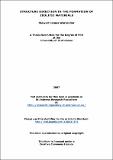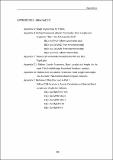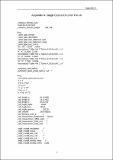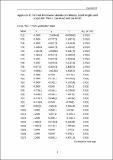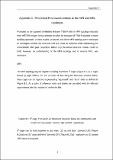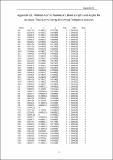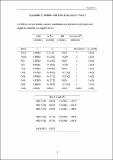Files in this item
Structure direction in the formation of zeolitic materials
Item metadata
| dc.contributor.advisor | Wright, Paul Anthony | |
| dc.contributor.author | Warrender, Stewart James | |
| dc.coverage.spatial | xii, 286 | en |
| dc.date.accessioned | 2007-09-14T15:58:39Z | |
| dc.date.available | 2007-09-14T15:58:39Z | |
| dc.date.issued | 2007 | |
| dc.identifier | uk.bl.ethos.552045 | |
| dc.identifier.uri | https://hdl.handle.net/10023/376 | |
| dc.description.abstract | Structure direction in the formation of zeolitic materials has been investigated through the parallel approaches of structural and synthesis studies. The structures of gallosilicates TNU-6 and TNU-7 have been solved from powder X-ray diffraction. TNU-6 (P6₃, a = b = 10.5078(1)Å, c = 8.5277(1)Å) is found to possess a stuffed tridymite-like structure isostructural with BaFeGaO₄. Evidence from electron diffraction, single crystal and high-resolution powder X-ray diffraction suggests the presence of a √3a superstructure, analogous to the related KAlGeO₄ phase, arising from a subtle variation in tilt of tetrahedral units. The structure of TNU-7 consists of an ordered 1:1 intergrowth of alternating sheets of mazzite and mordenite (Pmmn, a = 7.5721(1)Å, b = 17.0739(2)Å, c = 25.8438(5)Å). The crystallisation field of TNU-7 is found to lie between those of mazzite and mordenite, suggesting that this is an example of a ‘boundary phase’ - phase selectivity being governed strongly by the presence and quantity of Ga in the synthesis gel. The distribution of extra-framework Na⁺ cations in the as-made material, and Cs⁺ and Sr²⁺ in ion-exchanged samples, suggests a higher extra-framework charge per T-site associated with the mazzite region of the structure, indicating the possible existence of compositional zoning, consistent with the preference to form mazzite at high Ga gel-content. The structures and synthesis conditions for both TNU-6 and TNU-7 suggests a cooperative effect between Ga and extra-framework species in directing the formation of these phases. The structure of the novel aluminosilicate TNU-9 has been confirmed by energy minimisation and powder neutron diffraction studies (C2/m, a = 28.177(2)Å, b = 20.030(1)Å, c = 19.464(1)Å, β = 92.311(4)º ). Monte Carlo-Simulated Annealing studies have been employed to investigate the favoured location of the 1,4-bis(N- methylpyrrolidinium)butane template molecule within the complex pore system. Remarkably, three (possibly four) different positions are assumed by the structure-directing agent, forming head-to-middle and head-to-head motifs between constituent framework aluminosilicate sheets. TNU-9 crystallises in a very narrow gel composition window suggesting a strong cooperative effect between organic and inorganic gel components. Structure direction of phosphate-based materials (aluminophosphates, magnesium aluminophosphates and silicoaluminophosphates) has been investigated through co-templating synthesis studies. In particular, the structure-directing activity of Cu²⁺ (and to a lesser extent Ni²⁺) complexes of the azamacrocyles cyclam and cyclen, and related derivatives, is investigated in the presence of additional amines (dipropylamine, diisopropylamine, tetraethylammonium hydroxide, diisopropylethylamine). Complexes of a selection of linear polyamines, and also cobalticinium are studied for comparison. Although added primarily as pH moderators, the additional amines are also found to influence the crystallisation and hence provide effective routes to the synthesis of transition metal-containing materials with potential catalytic application. The ‘strength’ of the structure-directing ability of the additional amines is found to vary depending on the identity of the primary structure-directing agent, with behaviour ranging from passive pH moderator to dominating structure-directing agent. The outcome of syntheses is also highly dependent on inorganic gel composition. Through appropriate combination of structure-directing agent and additional amine, mixed Cu²⁺/Ni²⁺-containing MgAPO and SAPO STA-6 (SAS) and STA-7 (SAV) materials have been synthesised for the first time, as well as a low Si form of SAPO STA-7 (with and without Cu²⁺). Also, the combination of cyclam, tetraethylammonium hydroxide and HF has been found to produce a SAPO analogue of STA-7 possessing silicate islands. In addition, transition metal-containing materials possessing the AEL, AFI, CHA, UT-6 and LEV topologies have also been synthesised via this approach. Elemental analysis, UV-Vis, ESR and NMR spectroscopy are employed to confirm the presence of the desired complex in selected samples, while X-ray diffraction and ESR spectroscopy are employed to investigate the environment of extra-framework transition metal species, post calcination, in MgAPO STA-6, SAPO STA-6 and STA-7, MgAPO-18, and MgAPO-5. | en |
| dc.format.extent | 2675 bytes | |
| dc.format.mimetype | application/pdf | |
| dc.language.iso | en | en |
| dc.publisher | University of St Andrews | |
| dc.rights | Creative Commons Attribution-NonCommercial-NoDerivs 3.0 Unported | |
| dc.rights.uri | http://creativecommons.org/licenses/by-nc-nd/3.0/ | |
| dc.subject.lcc | TP159.M6W2 | |
| dc.subject.lcsh | Zeolites--Structure | en |
| dc.subject.lcsh | Zeolites--Synthesis | en |
| dc.subject.lcsh | Molecular sieves--Structure | en |
| dc.subject.lcsh | Molecular sieves--Synthesis | en |
| dc.title | Structure direction in the formation of zeolitic materials | en |
| dc.type | Thesis | en |
| dc.type.qualificationlevel | Doctoral | en |
| dc.type.qualificationname | PhD Doctor of Philosophy | en |
| dc.publisher.institution | The University of St Andrews | en |
This item appears in the following Collection(s)
Except where otherwise noted within the work, this item's licence for re-use is described as Creative Commons Attribution-NonCommercial-NoDerivs 3.0 Unported
Items in the St Andrews Research Repository are protected by copyright, with all rights reserved, unless otherwise indicated.

